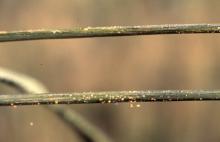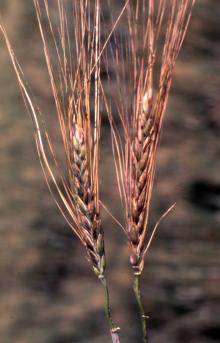Cause The bacterium, Xanthomonas translucens pv. undulosa (formerly X. campestris pv. translucens), infects many cereals (barley, oats, rye, triticale) and grasses. Severe epidemics are periodic in irrigated wheat. The pathogen may be seedborne or persist in soil and infected plant residue. The disease can spread by water, spike-visiting insects (aphids), plant-to-plant contact, and seeds.
Symptoms Symptoms generally appear after boot stage. Leaves develop small water-soaked spots, which develop into tan to dark-brown, black, or purple streak and may be surrounded by lime-green chlorotic tissue that merges out to the healthy tissue. Slimy droplets may develop on diseased tissue in wet weather. Initial symptoms often are on upper leaves in the middle of the blade. Entire leaves may die prematurely; if that is before the soft dough stage, yield reductions and shriveled grain of low-test weight may result.
Symptoms in heads consist of dark-brown, black, or purple streaks and blotches, frequently concentrated on the glumes' upper portions. Culms may have dark streaks, and kernels may be shrunken. Diseased heads mature late and may be sterile if infected before flowering.
Diagnosis must be careful-symptoms of brown necrosis, melanism, Septoria leaf blotch, glume blotch, and false black chaff are similar.
Cultural control Bacterial diseases are difficult to control once symptoms are evident in the field.
- The best control is to avoid the disease by planting pathogen-free seed.
- Irrigate less frequently and avoid overhead irrigation when possible.
- Plant tolerant or resistant varieties if available.





